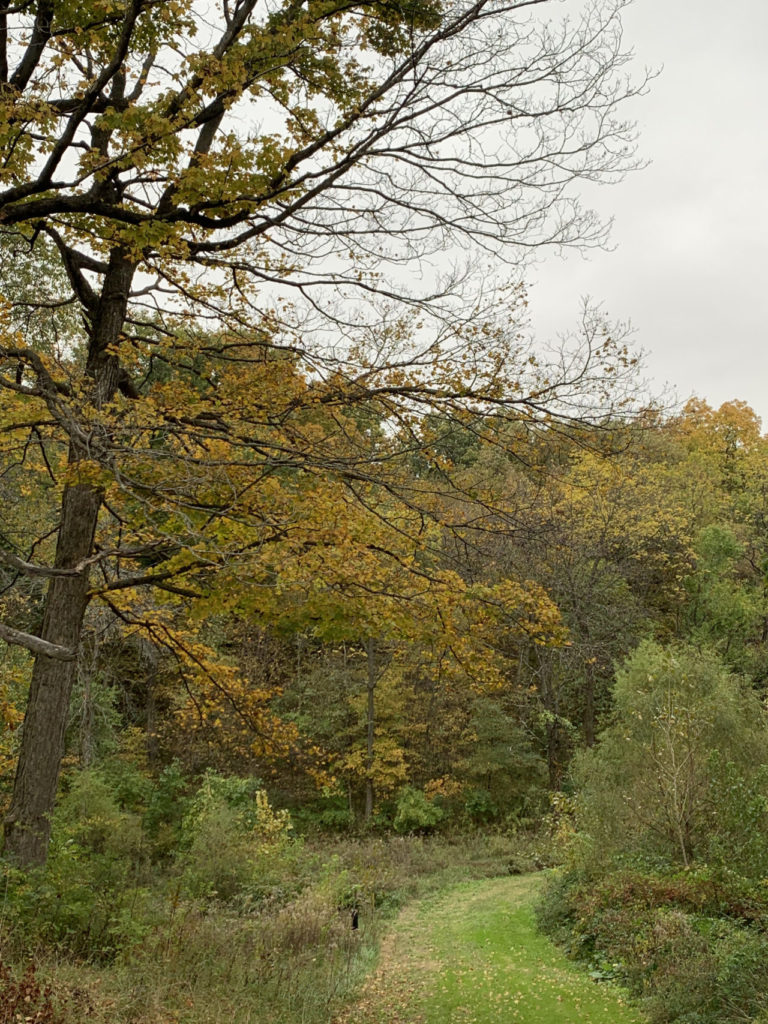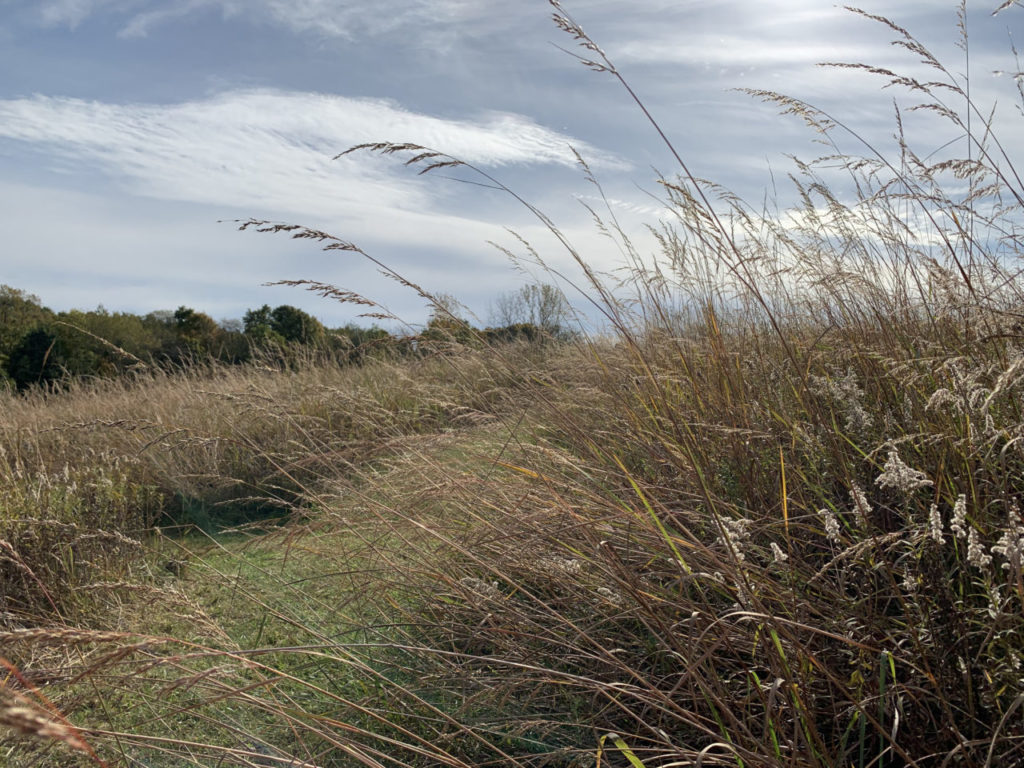Field Note: Letter from Blackthorn Hill
by Hai-Dang Phan | Contributing Writer
This essay is part of Poetry Northwest’s “Life List” feature.
Reconnecting with Blackthorn yesterday after a monthlong hiatus, I gained a new appreciation for the orange-crowned warbler. There were plenty of noteworthy birds on my hour-long ramble: a white-crowned sparrow couple standing out in the white-throated sparrow crowd, a winter wren bubbling and bobbing atop a flattened brush pile along the prairie edge, and a blue-headed vireo browsing the upper shelves of the sugar maples. But it was my encounter with that drabbest and tardiest of fall warblers foraging in a dense tangle of blackberry that has clung to me like a burr.
Gone is September with its waves of warblers enlivening almost any walk in green sunlit woods. As October approaches November, while the rest of the Parulidae family are settling into their winter homes in the tropics, the hardy orange-crowned warblers can still reassuringly be found throughout the lower forty-eight lingering about their favored shrubby haunts on their wayward journey south. Easily overlooked, when seen this warbler is most often described as dull, plain, drab, and nondescript; or, “a lonely, dark, obscure little bird,” as I come across in Arthur Cleveland Bent’s Life Histories of North American Wood Warbler. There are no odes to the orange-crowned warbler. Yet for me there is something about the mere presence of a solitary orange-crowned gleaning a dead leaf cluster in late October.
Which is why I am back at Blackthorn this morning, down where the first hill bottoms out into a willowy corridor with brushy edges watched over by some old remnant oaks. Swiftly, then slowly, I approach the spot, listening for a faint rustle or sharp chip call, looking for a telegraphing twitch, an aberration of sunlight and motion, or an insinuating vibration in the conspicuous pokeweed where I first noticed the bird. After ten minutes of fruitless searching, I know he is not going to show up, not here and now anyhow. It’s too early in the morning to be disappointed, and the prairie still beckons. Absence can also make the eyes grow sharper.
Up the next rise, before the woodland path swerves and opens up to reveal the hidden prairie, I hear the golden-crowned kinglets—their high thin call notes skidding across the air. They sound like squeaky bicycle wheels coming from up ahead. Then I see them, half a dozen hyperactive silhouettes fluttering in the same quaking aspen like gray tiny leaves rearranging themselves. Ever since I read that the songs and calls of golden-crowned kinglets are among the first sounds people lose their ability to hear as they age, I make it a point to listen.
The prairie is quiet and subdued today, and the sky is cloudy and moody with hazy sunlight. The tall grasses sway with somnolent sparrows; I don’t see them yet, but know they are there, sense them huddled and withholding, hidden in the undulating sweeps of texture and color. Soon, the sparrows begin to stir. The abundant white-throateds call back and forth, and one among them sings. The cool air smells of things long in their dying, quickening life. As I walk, birds dive deeper into the grasses like spooky trout disappearing into water. The gray-faced sparrow I manage to bring into focus; the bright-winged and rusty brown sparrow who leaves a dark impression on the golden field, I think, is a swamp sparrow. I am still learning my sparrows.
Blackthorn is not just a favorite local patch, it is also where my life as a birder began. Late spring, early in the pandemic, I discovered the 110-acre nature preserve while searching Google maps for green spaces within driving distance. Blackthorn Hill Nature Preserve not only had a poetic sounding name, it was less than ten miles northwest out of Galesburg, Illinois. During high summer and amid surging infection rates, if I was not at home, I was likely at Blackthorn looking for birds with my first pair of binoculars. Blackthorn is where I saw my first indigo bunting, electric blue and singing at the top of the morning. Blackthorn is where I identified my first warbler, a common yellowthroat chanting from the young oak in the middle of the prairie around noontime. And Blackthorn is where I sat in a sylvan theater listening to the wood thrush perform its ethereal song until last light. At the time, I was not writing much poetry, but I felt close to its source. Often I turned over in my head a pair of sentences from Rilke’s Malte Laurids Brigge: “I am learning to see. Everything enters into me more deeply and no longer stops where it once used to.”
In the field, looking and listening, I am never not a little bewildered. For example, these confusing sparrows. They remind me I’m at the beginning again, I know almost nothing, and this makes me happy. When another disappears into the field, I keep looking at the field itself: its burnt fuses of dead coneflowers, crumpled crowns of thistle, and burst pods of milkweed. And the grasses, the beautiful tall grasses. I would like to become better acquainted with Switchgrass, Indiangrass, Big Bluestem, and the wild rest. Of light and wind, they do not so much reflect the sun as glow from within. I run my fingers along the long smooth stems and stroke the plume-like seed heads until a cloud of seeds collects in my hand. I scatter the seeds to the wind, and the grasses erupt with wings.
So, when the orange-crowned springs up in the young locust tree amid the fleeing sparrows, I am all eyes. Here is the subtly-colored, delicately-appointed bird I want most to see today. As he flits among the slender branches thick with thorns, I try to keep the glass on him, taking in gestalt and atmospherics. His head is the color of fog, his dusky body a blur of olive-green-yellow. The faint streaks running down the sides of his breast are like the memory of spring rain. The image shakes, his fine pointed bill wavering like a silvery compass needle, his eye gleaming like a solar eclipse. He flips around, flashes diagnostic yellow beneath the tail, then sets off to see about the wine-dark sumac. There goes my orange-crowned, plain as day, faded as the last goldenrods, certainly not rare, definitely not colorful, yet altogether singular.
Almost noon, the clouds clear, the sun rides higher, and a red-tailed hawk circles on thermals in open sky now cerulean. Six crows quickly rise up against the hawk, darkening the space above the cottonwoods. They hurl crow talk and crow invective. When the blue jays sound their alarms from the woods at my back, I glance over my shoulder and see the arrowhead of another hawk plummeting to earth. Moments later, a short-winged, long-tailed accipiter, a cooper’s hawk, tears out of the forest edge, talons clasping a rope of air. I have seen this all before, I am learning to see again. The hawk reminds me there are birds, there are birds in the woods. That’s where I will go next, into the dark wood, to give my eyes a rest, though I know I won’t be done with looking.
—
Hai-Dang Phan is the author of the poetry collection Reenactments (Sarabande, 2019) and the translator of Phan Nhiên Hạo’s volume of poems Paper Bells (The Song Cave, 2020). He teaches at Grinnell College and lives in Iowa City.


